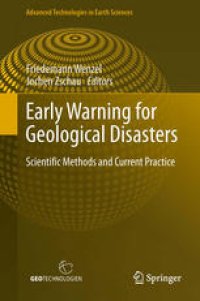
Ebook: Early Warning for Geological Disasters: Scientific Methods and Current Practice
- Tags: Geophysics/Geodesy, Geotechnical Engineering & Applied Earth Sciences, Natural Hazards, Geoecology/Natural Processes
- Series: Advanced Technologies in Earth Sciences
- Year: 2014
- Publisher: Springer-Verlag Berlin Heidelberg
- Edition: 1
- Language: English
- pdf
The past years have seen new technologies that could be utilized for early warning and real-time loss estimation. They include self-organizing sensor networks, new satellite imagery with high resolution, multi-sensor observational capacities, and crowd sourcing. From this and improved physical models, data processing and communication methodologies a significant step towards better early warning technologies has been achieved by research.
At the same time, early warning systems became part of the disaster management practice for instance in Japan and Indonesia. This book marks the important point where:
- Research activities continue to improve early warning
- Experience with applications is expanding
At this critical point in development of early warning for geological disasters it is timely to provide a volume that documents the state-of-the-art, provides an overview on recent developments and serves as knowledge resource for researcher and practitioners.
The past years have seen new technologies that could be utilized for early warning and real-time loss estimation. They include self-organizing sensor networks, new satellite imagery with high resolution, multi-sensor observational capacities, and crowd sourcing. From this and improved physical models, data processing and communication methodologies a significant step towards better early warning technologies has been achieved by research.
At the same time, early warning systems became part of the disaster management practice for instance in Japan and Indonesia. This book marks the important point where:
- Research activities continue to improve early warning
- Experience with applications is expanding
At this critical point in development of early warning for geological disasters it is timely to provide a volume that documents the state-of-the-art, provides an overview on recent developments and serves as knowledge resource for researcher and practitioners.
The past years have seen new technologies that could be utilized for early warning and real-time loss estimation. They include self-organizing sensor networks, new satellite imagery with high resolution, multi-sensor observational capacities, and crowd sourcing. From this and improved physical models, data processing and communication methodologies a significant step towards better early warning technologies has been achieved by research.
At the same time, early warning systems became part of the disaster management practice for instance in Japan and Indonesia. This book marks the important point where:
- Research activities continue to improve early warning
- Experience with applications is expanding
At this critical point in development of early warning for geological disasters it is timely to provide a volume that documents the state-of-the-art, provides an overview on recent developments and serves as knowledge resource for researcher and practitioners.
Content:
Front Matter....Pages i-xv
Earthquake Early Warning and Tsunami Warning of the Japan Meteorological Agency, and Their Performance in the 2011 off the Pacific Coast of Tohoku Earthquake ( ${M}_{{mathrm{w}}}$ 9.0)....Pages 1-28
Estimation of Fault Rupture Extent Using Near-Source Records for Earthquake Early Warning....Pages 29-47
CISN ShakeAlert: An Earthquake Early Warning Demonstration System for California....Pages 49-69
The Mexican Seismic Alert System (SASMEX): Its Alert Signals, Broadcast Results and Performance During the M 7.4 Punta Maldonado Earthquake of March 20th, 2012....Pages 71-87
Development of Earthquake Early Warning Systems in the European Union....Pages 89-101
EDIM: Earthquake Disaster Information System for the Marmara Region, Turkey....Pages 103-116
An Integrated Regional and On-Site Earthquake Early Warning System for Southern Italy: Concepts, Methodologies and Performances....Pages 117-137
Earthquake Early Warning for Transport Lines....Pages 139-163
The Earthquake and Tsunami Early Warning System for the Indian Ocean (GITEWS)....Pages 165-178
Walking the Last Mile: Contributions to the Development of an End-to-End Tsunami Early Warning System in Indonesia....Pages 179-206
The Last-Mile Evacuation Project: A Multi-disciplinary Approach to Evacuation Planning and Risk Reduction in Tsunami-Threatened Coastal Areas....Pages 207-226
The Role of Information and Communication Technology in the Development of Early Warning Systems for Geological Disasters: The Tsunami Show Case....Pages 227-252
A Test of Earthquake Early Warning System Using Low Cost Accelerometer in Hualien, Taiwan....Pages 253-261
Applications of a Low-Cost, Wireless, Self-Organising System (SOSEWIN) to Earthquake Early Warning and Structural Health Monitoring....Pages 263-288
Low Cost 3D Early Warning System for Alpine Instable Slopes: The Aggenalm Landslide Monitoring System....Pages 289-306
Operational Integration of Spaceborne Measurements of Lava Discharge Rates and Sulfur Dioxide Concentrations for Global Volcano Monitoring....Pages 307-331
Engineering Earthquake Early Warning via Regional Networks....Pages 333-351
Operational Earthquake Forecasting and Decision-Making....Pages 353-367
How Useful is Early Warning and Can It Be Made More Effective?....Pages 369-379